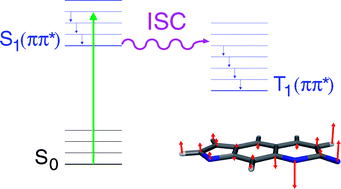For 7H-furo[3,2-g][1]benzopyran-7-one (psoralen), intersystem crossing (ISC) rate constants have been computed. Employing the Fermi golden rule, the harmonic approximation, and a pure-spin Born–Oppenheimer basis, both direct and vibronic spin–orbit (SO) coupling has been taken into account. Necessary data on electronic excitation energies and potential energy hypersurfaces originate from correlated all-electron calculations applying (time-dependent) density functional theory and the density functional theory/multireference configuration interaction approach. SO coupling has been treated by means of the one-center mean-field approximation. Vibronic SO couplings have been evaluated via numerical differentiation of SO matrix elements. Accounting only for direct SO coupling, rate constants of the order of kISC
≈ 1010 s−1 result for S2(n →
π*) ![[long arrow, wavy then straight]](https://www.rsc.org/images/entities/char_e0f6.gif) T1(π
→
π*) ISC, whereas the rates of the channels S1(π
→
π*)
T1(π
→
π*) ISC, whereas the rates of the channels S1(π
→
π*) ![[long arrow, wavy then straight]](https://www.rsc.org/images/entities/char_e0f6.gif) T{1,2,3}(π
→
π*) do not exceed kISC
≈ 105 s−1. Including vibronic SO coupling, rate constants of kISC
≈ 3 × 108 s−1 are obtained for the S1(π
→
π*)
T{1,2,3}(π
→
π*) do not exceed kISC
≈ 105 s−1. Including vibronic SO coupling, rate constants of kISC
≈ 3 × 108 s−1 are obtained for the S1(π
→
π*) ![[long arrow, wavy then straight]](https://www.rsc.org/images/entities/char_e0f6.gif) T1(π
→
π*) ISC. The radiationless transition from the S1(π
→
π*) state to the nearly degenerate T3(π
→
π*) state has been estimated to be slightly less efficient (kISC
≈ 107 s−1). Based on our computed rates of ISC and excited state solvent shifts, we conclude that the experimentally observed appreciable triplet quantum yields of psoralen in polar protic media are primarily due to S1(π
→
π*)
T1(π
→
π*) ISC. The radiationless transition from the S1(π
→
π*) state to the nearly degenerate T3(π
→
π*) state has been estimated to be slightly less efficient (kISC
≈ 107 s−1). Based on our computed rates of ISC and excited state solvent shifts, we conclude that the experimentally observed appreciable triplet quantum yields of psoralen in polar protic media are primarily due to S1(π
→
π*) ![[long arrow, wavy then straight]](https://www.rsc.org/images/entities/char_e0f6.gif) T(π
→
π*) channels. For heteroaromatic systems, (π
→
π*)/(π
→
π*) ISC driven by vibronic SO coupling is expected to be a common triplet state population mechanism.
T(π
→
π*) channels. For heteroaromatic systems, (π
→
π*)/(π
→
π*) ISC driven by vibronic SO coupling is expected to be a common triplet state population mechanism.

You have access to this article
 Please wait while we load your content...
Something went wrong. Try again?
Please wait while we load your content...
Something went wrong. Try again?
![[long arrow, wavy then straight]](https://www.rsc.org/images/entities/char_e0f6.gif) T1(π
→
π*) ISC, whereas the rates of the channels S1(π
→
π*)
T1(π
→
π*) ISC, whereas the rates of the channels S1(π
→
π*) ![[long arrow, wavy then straight]](https://www.rsc.org/images/entities/char_e0f6.gif) T{1,2,3}(π
→
π*) do not exceed kISC
≈ 105 s−1. Including vibronic SO coupling, rate constants of kISC
≈ 3 × 108 s−1 are obtained for the S1(π
→
π*)
T{1,2,3}(π
→
π*) do not exceed kISC
≈ 105 s−1. Including vibronic SO coupling, rate constants of kISC
≈ 3 × 108 s−1 are obtained for the S1(π
→
π*) ![[long arrow, wavy then straight]](https://www.rsc.org/images/entities/char_e0f6.gif) T1(π
→
π*) ISC. The radiationless transition from the S1(π
→
π*) state to the nearly degenerate T3(π
→
π*) state has been estimated to be slightly less efficient (kISC
≈ 107 s−1). Based on our computed rates of ISC and excited state
T1(π
→
π*) ISC. The radiationless transition from the S1(π
→
π*) state to the nearly degenerate T3(π
→
π*) state has been estimated to be slightly less efficient (kISC
≈ 107 s−1). Based on our computed rates of ISC and excited state ![[long arrow, wavy then straight]](https://www.rsc.org/images/entities/char_e0f6.gif) T(π
→
π*) channels. For heteroaromatic systems, (π
→
π*)/(π
→
π*) ISC driven by vibronic SO coupling is expected to be a common triplet state population mechanism.
T(π
→
π*) channels. For heteroaromatic systems, (π
→
π*)/(π
→
π*) ISC driven by vibronic SO coupling is expected to be a common triplet state population mechanism.

 Please wait while we load your content...
Please wait while we load your content...